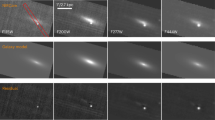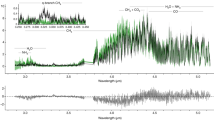Abstract
There is a general consensus that planets form within disks of dust and gas around newly born stars1,2. Details of their formation process, however, are still a matter of ongoing debate. The timescale of planet formation remains unclear, so the detection of planets around young stars with protoplanetary disks is potentially of great interest. Hitherto, no such planet has been found. Here we report the detection of a planet of mass (9.8±3.3)MJupiter around TW Hydrae (TW Hya), a nearby young star with an age of only 8–10 Myr that is surrounded by a well-studied circumstellar disk. It orbits the star with a period of 3.56 days at 0.04 au, inside the inner rim of the disk. This demonstrates that planets can form within 10 Myr, before the disk has been dissipated by stellar winds and radiation.
This is a preview of subscription content, access via your institution
Access options
Subscribe to this journal
Receive 51 print issues and online access
$199.00 per year
only $3.90 per issue
Buy this article
- Purchase on Springer Link
- Instant access to full article PDF
Prices may be subject to local taxes which are calculated during checkout




Similar content being viewed by others
References
Safronov, V. S. The protoplanetary cloud and its evolution. Sov. Astron. 10, 650–658 (1967)
Pollack, J. B. et al. Formation of the giant planets by concurrent accretion of solids and gas. Icarus 124, 62–85 (1996)
Mayor, M. & Queloz, D. A. Jupiter-mass companion to a solar-type star. Nature 378, 355–359 (1995)
The Extrasolar Planet Encyclopedia 〈www.exoplanet.eu〉
Boss, A. P. Gas giant protoplanet formation. disk instability models with thermodynamics and radiative transfer. Astrophys. J. 563, 367–373 (2001)
Haisch, K. E., Lada, E. A. & Lada, C. J. Disk frequencies and lifetimes in young clusters. Astrophys. J. 553, L153–L156 (2001)
Cieza, L. et al. The Spitzer c2d Survey of weak-line T-Tauri stars. II. New constraints on the timescale for planet building. Astrophys. J. 667, 308–328 (2007)
Carpenter, J. M. et al. Evolution of cold circumstellar dust around solar-type stars. Astron. J. 129, 1049–1062 (2005)
Chauvin, G. et al. Giant planet companion to 2MASSW J1207334–393254. Astron. Astrophys. 438, L25–L28 (2005)
Setiawan, J. et al. Evidence for a planetary companion around a nearby young star. Astrophys. J. 660, L145–L148 (2007)
Krist, J. E. et al. WFPC2 images of a face-on disk surrounding TW Hydrae. Astrophys. J. 538, 793–800 (2000)
Qi, C. et al. Imaging the disk around TW Hydrae with the submillimeter array. Astrophys. J. 616, L11–L14 (2004)
Calvet, N. et al. Evidence for a developing gap in a 10 Myr old protoplanetary disk. Astrophys. J. 568, 1008–1016 (2002)
Hughes, A. M. et al. An inner hole in the disk around TW Hydrae resolved in 7 mm dust emission. Astrophys. J. 664, 536–542 (2007)
Ratzka, T. et al. High spatial resolution mid-infrared observations of the low-mass young star TW Hya. Astron. Astrophys. 471, 173–185 (2007)
Rettig, T. W. et al. Discovery of CO gas in the inner disk of TW Hydrae. Astrophys. J. 616, L163–L166 (2004)
Salyk, C., Blake, G. A., Boogert, A. C. A. & Brown, J. M. Molecular gas in the inner 1 AU of the TW Hya and GM Aur transitional disks. Astrophys. J. 655, L105–L108 (2007)
Eisner, J. A., Chiang, E. I. & Hillenbrand, L. A. Spatially resolving the inner disk of TW Hydrae. Astrophys. J. 637, L133–L136 (2006)
Muzerolle, J. et al. Disk accretion in the 10 Myr old T Tauri stars TW Hydrae and Hen 3–600A. Astrophys. J. 535, L47–L50 (2000)
Kaufer, A. et al. Performance report on FEROS, the new fiber-linked echelle spectrograph at the ESO 1.52-m telescope. In Proc. SPIE Optical and IR Telescope Instrumentation and Detectors. 4008, 459–466 (2000)
Setiawan, J. et al. Precise radial velocity measurements of G and K giants. First results. Astron. Astrophys. 397, 1151–1159 (2003)
Herbst, W. & Koret, D. L. Rotation periods of four T Tauri stars. Astron. J. 96, 1949–1955 (1988)
Mekkaden, M. V. Photometric and polarimetric variability of the isolated T Tauri star TW Hydrae. Astron. Astrophys. 340, 135–142 (1998)
Alencar, S. H. P. & Batalha, C. Variability of southern T Tauri stars. II. The spectral variability of the classical T Tauri star TW Hydrae. Astrophys. J. 571, 378–393 (2002)
Alibert, Y., Mordasini, C., Benz, W. & Winisdoerffer, C. Models of giant planet formation with migration and disc evolution. Astron. Astrophys. 434, 343–353 (2005)
Matsuo, T., Shibai, H., Ootsubo, T. & Tamura, M. Planet formation scenarios revisited: core accretion versus disk instability. Astrophys. J. 662, 1282–1292 (2007)
Boss, A. Evolution of the solar nebula. VII. Planet formation and survival of protoplanets formed by disk instability. Astrophys. J. 629, 535–548 (2005)
Papaloizou, J. C. B. Disk-planet interaction during planet formation. Protostars Planets 5, 655–668 (2007)
Cumming, A., Marcy, G. W. & Butler, R. P. The Lick planet search: detectability and mass thresholds. Astrophys. J. 526, 890–915 (1999)
Kürster, M., Schmitt, J. H. M. M., Cutispoto, G. & Dennerl, K. ROSAT and AB Doradus: the first five years. Astron. Astrophys. 320, 831–839 (1997)
Acknowledgements
We thank the 2.2 m MPG/ESO La Silla team, especially P. Francois, B. Conn, M. Stefanon, O. Schütz, M. Morell and A. Gonzales for their help during the observations. We thank W. Herbst for constructive discussion and providing the supporting data.
Author Contributions The observations were carried out by J.S. and A.M.; T.H. and R.L. were responsible for the project planning. The data analysis was done by J.S., A.M., P.W. and M.K.
Author information
Authors and Affiliations
Corresponding authors
Supplementary information
Supplementary Information
The file contains Supplementary Tables 1-3; Supplementary Figures 1-3 with Legends; Supplementary Discussion; Supplementary Notes; Supplementary Methods and additional references. (PDF 293 kb)
Rights and permissions
About this article
Cite this article
Setiawan, J., Henning, T., Launhardt, R. et al. A young massive planet in a star–disk system. Nature 451, 38–41 (2008). https://doi.org/10.1038/nature06426
Received:
Accepted:
Issue Date:
DOI: https://doi.org/10.1038/nature06426
This article is cited by
-
A measure of the size of the magnetospheric accretion region in TW Hydrae
Nature (2020)
-
A hot Jupiter orbiting a 2-million-year-old solar-mass T Tauri star
Nature (2016)
-
High precision radial velocities with GIANO spectra
Experimental Astronomy (2016)
Comments
By submitting a comment you agree to abide by our Terms and Community Guidelines. If you find something abusive or that does not comply with our terms or guidelines please flag it as inappropriate.



